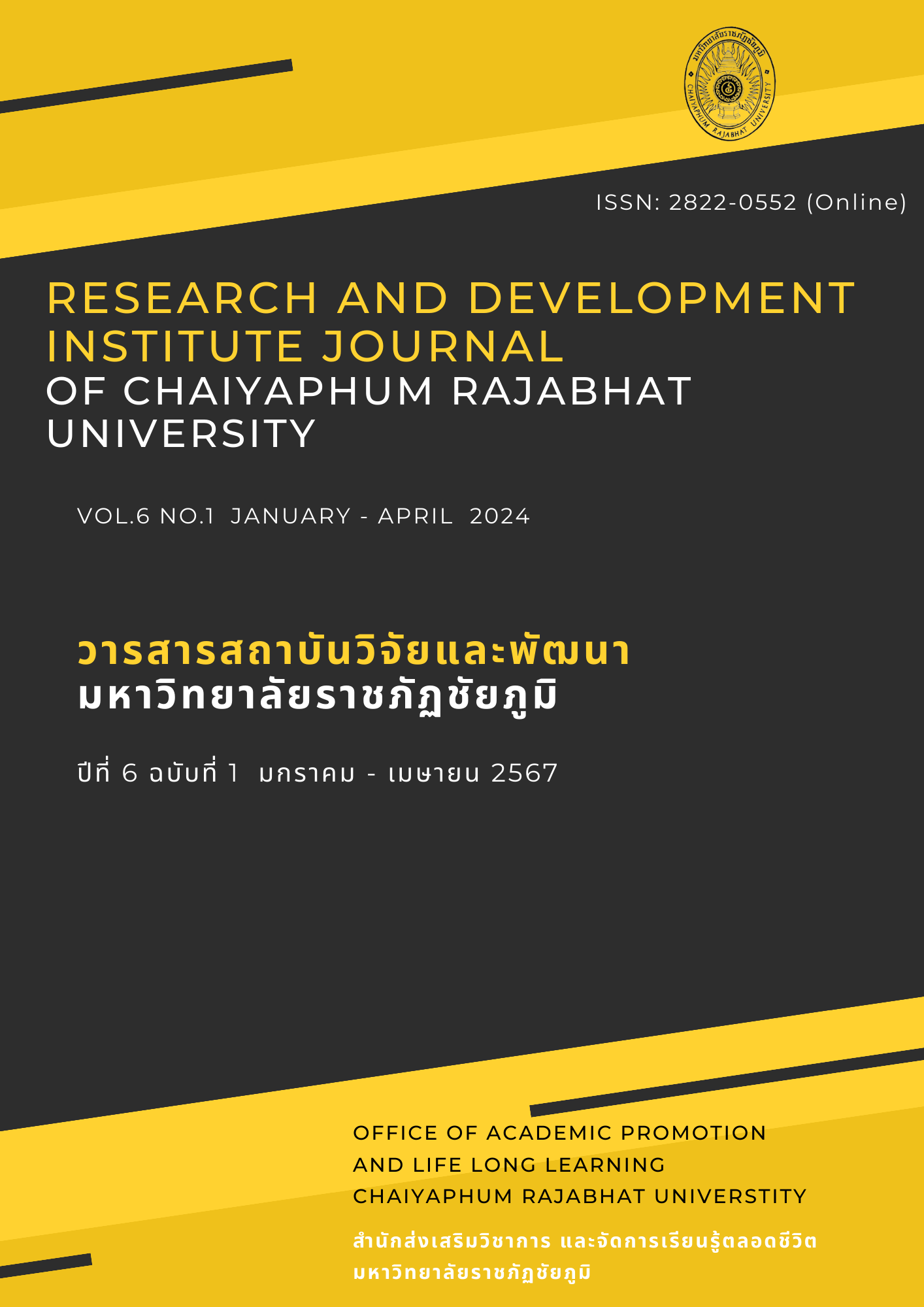THE DEVELOPMENT OF MATHEMATIC LEARNING ACHIEVEMENT ON THE PROBLEM OF CIRCLE PROBLEMS BY USING THE KWDL TECHNIQUE IN CONJUNCTION WITH THE KAHOOT APPLICATION FOR GRADE 6 STUDENTS
Main Article Content
Abstract
The purposes of this research were 1) to compare the learning of grade 6 students before and after learning with KWDL technique together with the Kahoot application. The sample consisted of 32 students in grade 6/6, in the first semester academic year 2023, Anubanchaiyaphum School, Muang district, Chaiyaphum province. They were selected by Cluster random sampling. The research tools consisted of 1) a lesson plan using the KWDL technique together with the Kahoot application on the problem of circle Mathematics learning group of grade 6 students, 2) a mathematics learning achievement Test of grade 6 students on the problem of the circle using the experimental one-group pretest-posttest design. The statistics used in this study were mean, standard deviation, and dependent sample t-test.
The results of the research were: 1) the students' learning achievement after learning with the KWDL technique together with the Kahoot application on the problem of circle was higher than before learning with the KWDL technique together with the Kahoot application on the problem of circle at the statistically significant level of .05
Article Details

This work is licensed under a Creative Commons Attribution-NonCommercial-NoDerivatives 4.0 International License.
Permission to use text, content, images, etc. of publication. Any user to read, download, copy, distribute, print, search, or link to the full texts of articles, crawl them for indexing, pass them as data to software, or use them for any other lawful purpose. But do not use it for commercial use or with the intent to benefit any business. Published under a Creative Commons Attribution-NonCommercial-NoDerivatives 4.0 International License.

This work is licensed under a Creative Commons Attribution-NonCommercial-NoDerivatives 4.0 International License
References
กระทรวงศึกษาธิการ. (2552). หลักสูตรแกนกลางการศึกษาขั้นพื้นฐานพุทธศักราช 2551. กรุงเทพมหานคร: ชุมนุมสหกรณ์การเกษตรแห่งประเทศไทย.
กระทรวงศึกษาธิการ. (2551). เอกสารประกอบหลักสูตรแกนกลางการศึกษาขั้นพื้นฐาน พุทธศักราช 2551. กรุงเทพมหานคร: ชุมนุมสหกรณ์การเกษตรแห่งประเทศไทย.
จรัญ กองศรีกุลดิลก. (2552). การพัฒนาความสามารถในการแก้โจทย์ปัญหาคณิตศาสตร์โดยใช้แบบฝึกกิจกรรมการแก้ปัญหาคณิตศาสตร์ที่เน้นการวางแผนการแก้ปัญหา ของนักเรียนชั้นประถมศึกษาปีที่ 6 โรงเรียนวัดบางกุฎีทอง จังหวัดปทุมธานี. [วิทยานิพนธ์ปริญญามหาบัณฑิต]. มหาวิทยาลัยราชภัฏพระนคร.
จีระพงษ์ โพพันธุ์. (2562). ศึกษาการพัฒนาบทเรียนออนไลน์เทคโนโลยีสารสนเทศ. ครูไอที. https://kru-it.com/dt-m1/meaning-of-technology/
บุญชม ศรีสะอาด. (2545). การวิจัยเบื้องต้น.กรุงเทพฯ: สุรีวิริยาสาสน์.
พรรณี อุ่นละม้าย. (2563). การจัดกิจกรรมเสริมการเรียนรู้ เรื่อง อัตราส่วนตรีโกณมิติโดยใช้โปรแกรม Kahoot สําหรับนักเรียนชั้นมัธยมศึกษาปีที่ 4 โรงเรียนปราโมชวิทยารามอินทรา. วารสารวิจัยราชภัฏพระนคร สาขามนุษยศาสตร์และสังคมศาสตร์, 14(1), 176 – 191.
วิจารณ์ พานิช. (2560). วิถีสร้างการเรียนรู้เพื่อศิษย์. กรุงเทพมหานคร: ตถาตา พับลิเคชัน.
วิศรุต ตะกรุดแจ่ม. (2562). การศึกษาผลสัมฤทธิ์ทางการเรียน และการคิดวิเคราะห์ เรื่อง โจทย์ปัญหาร้อยละ โดยใช้การจัดการเรียนรู้แบบ KWDL ของนักเรียนชั้นประถมศึกษาปีที่ 6. [วิทยานิพนธ์ปริญญามหาบัณฑิต]. มหาวิทยาลัยราชภัฏชัยภูมิ.
สมพร กุลนานนท์ . (2560). การใช้สื่อการสอนโปรแกรม Kahoot Application ในการวัดและประเมินผล. วิทยาลัยเทคโนโลยีเมืองชลบริหารธุรกิจ. https://www.m-bac.ac.th/attachments/view/?attach_id=263201

